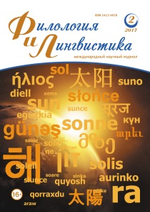Problems of grammatical and conceptual meaning in the structure of language
Авторы: Тургунова Эркиной Эргашевна, Халимова Мухайё Мухаммедовна
Рубрика: Вопросы переводоведения
Опубликовано в Филология и лингвистика №2 (6) июнь 2017 г.
Дата публикации: 05.06.2017
Статья просмотрена: 24 раза
Библиографическое описание:
Тургунова, Э. Э. Problems of grammatical and conceptual meaning in the structure of language / Э. Э. Тургунова, М. М. Халимова. — Текст : непосредственный // Филология и лингвистика. — 2017. — № 2 (6). — С. 83-84. — URL: https://moluch.ru/th/6/archive/59/2536/ (дата обращения: 25.04.2024).
As it is known, that the language is a relation of communication among people. People always need to communicate with each other everywhere and every time. We have to take into a concideration that there are different features between languages in the structure of phonetics, in grammar and in vocabulary. These parts of language is related with each other and makes the whole language and its system. As we know, a word is the main part of a language and in some languages it is an independent part of it. It is an independent unit when it has its own grammatical and conceptual structure. We can not refuse the role of a word in language. If we give a definition to the word, itis a single distinct meaningful element of speech or writing used with others (or sometimes alone) to form a sentence and typically shown with a space on either side when written or printed or one of the units of speech or writing that native speakers of a language usually regard as the smallest isolable meaningful element of the language, although linguists would analyse these further into morphemes.
According to the written structure the word is the combination of letters. But it is based on structural, grammatical and conceptual features too. Another definition of the word is more based on its lexical, semantical and grammatical features. The word is divided according to its structure and meaning. If the word consists of one morpeme it does not divided into another parts, head, stone, way, etc. But the most of words can be divided into several parts and they are organized with the relation of different morphemes. For example, headline, railway, sunflower,etc. The stem of these words has an independent meaning. When we speak about the word, we have to take into considiration that meaning is connected with an idea and they begin to relate with one another.
Relationship is a logical category, and it has lexical meaning, but the word is another category which is connected with the structure of a language. The meaning between the word and relationship, its lexical meaningis differentiated with other features, too. Relationship (concern,term) is expressed not only by word but another parts of a language, especially with phraseological units or idioms, too, the ministry of finance, expression of interest,extension of thanks, shift the blame on smb, etc.
To express the atititude is related only independent words, especially such words that has nominative meaning. The words which has no nominative meaning(pronouns), or non independent words (auxiliary words, interjections) can not expressed concern(meaning), but they have their own meaning too like oh, yes, no, high, wow,etc. These words express feeling, and hope or astonish.
The smallest part of the language a morpheme expresses the stem and suffexes,independent words have another syntactical features as a sentence: Winter. Cold. Darkness.
As we have mentioned, word is a unut which has a structure and meaning. It is learned by the following types:
1) according to the phonological features, we learn its phonemic system and the structure of stress;
2) according to the morphological feature, we analyse and learn the structure ofmorpheme;
3) according to the lexical point of view, we have to pay attention that a word is a unit of name (nomination),or the feature how to name;
4) according to the semantic feature, we learn different meanings of a word;
According to the 1st and the 2nd phonological and morphological features, we learn the structure and according to the 3rd and the 4th features it is learned lexical and semantic features. Besides this the word has original andfigurative meaning. Also it has monosemantic and polysemantic features, according to their semantic features (synonyms, homonyms, antonyms, paranyms) too. For example, little and big, good and bad, high and low(in Uzbek some words like оқ-қора, катта-кичик, яхши- ёмон, баланд-паст,узун-қисқа are antonymic words, the words like гўзал, чиройли, жозибали, мафтункор, ёқимтой; юз, бет, чеҳра, ораз, турқ, башара are synonymic words). We know that homonyms are one of a group of words pronounced or spelt in the same way but have different meanings and origins (e.g., pole I and pole II).
In its place, phrasal vebs and idioms have structural and conceptual meaning too. We may take the following examples for them:
In English: fed up with-lose patience, in Uzbek: Toқaти тoқ бўлмоқ-сaбр кoсaси тўлмоқ, in Russian: сытый по горло — чаша терпения переполниласъ;
in English: to like- to be fond of to love, in Uzbek: яхши кўрмоқ-кўнгил бермоқ, in Russian: нравиться — любить кого-,чего-л;
We have to keep in mind that the word has grammatical and logical meaning too. These meanings are differentiated with each other. Logical meaning is a term,which has its own meaning, and grammatical meaning is its structure.For example, a book: a) it is a thing;b) it is a common noun, countable, singular form.
(a school, a shop, a bread, a market, a car, a lecture, anewspaper, a street, etc)
We always use the words in different meanings. Words are connected with each other in order to make a sentence and express the certain informations. In its place, sentences make a text. Text consists of sentences which gives an information about something.
References:
- Нурманов А., Маҳмудов Н., Собиров А., Юсупова Ш. Ҳозирги ўзбек тили. — Тошкент: «Илм зиё", 2005
- Шоабдураҳмонов Ш. Асқарова М. Ҳозирги замон ўзбек адабий тили.-Тошкент, 1986
- Турсунов У., Мухторов Ж., Раҳматуллаев Ш. Ҳозирги ўзбек адабий тили. — Тошкент, 1975







